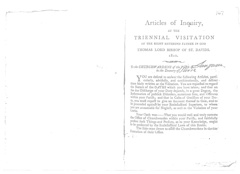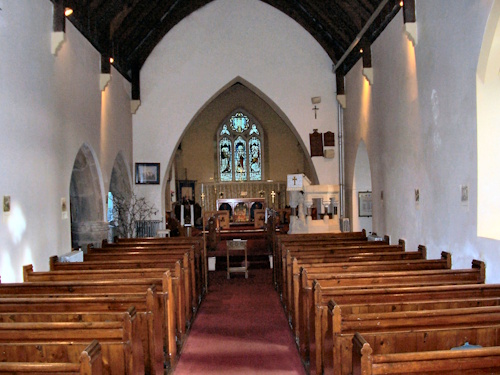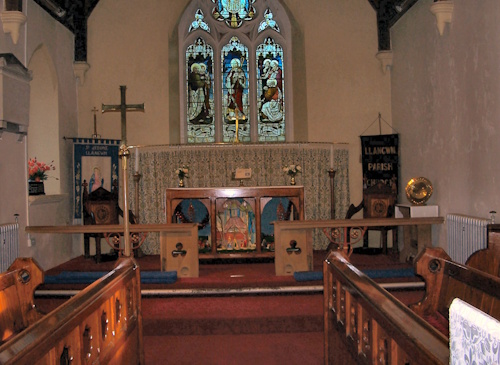St Jerome's Church
St Jerome's church was built sometime between 1185 and 1215 . However, two 10th-11th century grave covers suggest that there was some sort of religious establishment on this site before the Norman invasion of South Wales. The village name of Llangwm, translated from Welsh also points to the existence of early Christian worship in this village.
The building of the church as we know it now was funded by Adam De La Roche, the eldest grandson of Godebert the Fleming who, recently discovered evidence suggests, settled in this village around 1120 at what is now Great Nash Farm.
By the mid 14th century, the De La Roche family who had risen in prominence, built a family chapel, which today is the north transept and home to the Talking Tapestry of Langum and the Sunday School. By the early 15th century the main line of the De La Roche family had died out in Pembrokeshire, but the Roche / Roach dynasty thrives today in the UK, Ireland and other parts of the world.
Over the centuries, the nave and chancel have undergone many renovations and in 1835, the main body of the church was virtually rebuilt. Again in 1879, further major building works saw the addition of a porch, the raising of the floor in the chancel and lowering of the floor in the nave.
In 2016 with the financial support of the Heritage Lottery Fund, CADW and other trusts and foundations, the church underwent another major renovation to introduce 21st century technologies and environment-friendly heating and lighting systems, while still maintaining the medieval character that the church once had.
Articles of Enquiry at the Triennial Visitation of the Right Reverend Father in God Thomas, Lord Bishop of St Davids, 1810
Click on the image to view the full document.
Documents Concerning the 1879 Restoration of the Church
As mentioned above, St Jerome's underwent a programme of restoration in 1879. The following two files are scans of the work specification, and the architectural plans that were drawn up detailing the work to be undertaken. Click on the images to view the full documents.
Specification for the Restoration of St Jerome's Church 1879
Plans for the Restoration of St Jerome's Church 1879
Lady Anne Barlow Plaque
Lady Anne Barlow was the daughter of Philip Champion de Crespigny, Member of Parliament for Aldeburgh, Suffolk. She was the second wife of Hugh Owen Barlow of Lawrenny, who was also an MP between 1774 and his death, for Pembrokeshire boroughs.
She was widowed in 1809 and a large part of the Lawrenny estate was left to her for her lifetime and she lived for many years more, finally dying at Lawrenny in 1844. She obviously continued to be interested in the estate and its people, for in her will dated 1834, she made provision for a fund to be set up for the benefit of the poor and infirm of several parishes, including that of Llangwm. This came to be known as ‘Madam Barlow’s Fund’ and the distribution in Llangwm, ‘annually and forever’ of £10 was recorded in notebooks. These little books detail the Payment of amounts over the years such as 3/3d for widows and orphans of the parish and records many local names.
To commemorate the bequest, a large board, detailing the conditions in the will, was erected in St Jerome’s Church and hangs in the Chapel. The fund has recently been ‘wound up’ in consultation with the Charity Commissioners, and the small sum remaining in the fund distributed in accordance with the original conditions.
The board reads:
Mrs Anne Barlow
(who died the 7th July 1844) widow of the late Hugh Barlow of Lawrenny
in the County of Pembroke Esq. by her Will dated the 22nd day of November
1834 and proved in the Prerogative Court of Canterbury on the 2nd day
of August 1844. Gave as follows:
“I give to the Poor of the Parish of Lawrenny in the said County of Pembroke the
Sum of Twenty Pounds annually for ever. And to the Poor of the Parish of
Langum, Rosemarket and Nolton the Sum of Ten Pounds each annually for ever.
All free of Duty. And I direct a sufficient Sum to be invested in some or one of the
Government funds to Produce the four last mentioned Annuities in such name or
names as Sir John Owen MP or in case of his decease before me then as my other
Executors shall direct, and I desire that such Annuities respectively may be
distributed amongst such poor persons of the respective parishes as aforesaid as
are unable from Age, bodily, or mental infirmity to provide for themselves. And
that during the life of the said Sir John Owen, the said Annuities shall be
distributed and disposed of to the helplefs poor of the above named parishes
agreeably to his direction and under his control, and I request him in his life time
to adapt such arrangements as he may think proper for the future distribution
thereof”
Signed: Mifs Fanny Champion Crespigny, Capt. George Michael Kean,
Sir John Owen, Bart. Executors
Three Rectors of Llangwm
The Rectors of the Church of St Jerome’s in Llangwm number about 55 from 1433 to the present day as can be seen on the adjacent photograph; evidence of an even earlier rector JOHN DON from 1420 has also been found. However, little is known about the lives of most of the rectors but 3 names in particular are worthy of note.
PEREGRINE PHILLIPS is the most lively and charismatic of the Rectors. Born 1623, died 1691 he was appointed as Rector in 1643 and was here in Llangwm during the turbulent times of the Civil War, the establishment of the Protectorate under Oliver Cromwell, and the rise of non-conformism throughout the country.
His father, Edward Phillips, displayed positive Puritan sympathies while he was rector of Amroth, and Peregrine followed in his father’s footsteps. After his education at Haverfordwest grammar school and in Hereford, he went up to Oxford before taking orders. He was curate to his uncle at Kidwelly before being presented with the living of Llangwm & Freystop in 1643.
He soon became known as a talented and energetic preacher, preaching three sermons each Sunday and attracting the interest of local dignitaries. Eventually, it is said, he was noticed by Cromwell and asked to preach to the troops at Pembroke and on board the Puritan ships in the harbour.
Peregrine enjoyed the freedom from restraint in evangelical terms during the period of the Commonwealth, and he redoubled his labours in the non-conformist cause, preaching throughout the County and attracting many followers with his enthusiasm. However after the restoration of the monarchy in 1660, the enforcement of a more dogmatic form of Anglicanism, and suppression of non-conformity, meant that Peregrine could no longer continue as a minister of the church. He refused to swear the oath required by the Act of Uniformity that he would only conduct services in accordance with the Book of Common Prayer, and was therefore expelled from the living of Llangwm & Freystrop, and also required not to come within five miles of the parish.
He therefore moved to Haverfordwest and set up an Independent House Church (which eventually became the Albany Congregational on St Thomas’ Green), and continued his work for the non-conformist cause. In the course of this work he was often under pressure to conform but in 1672 the Declaration of Indulgence granted him licence to conduct services in his own house, and by 1689 worship was allowed in specifically registered buildings.
He died in 1691, widely respected for his integrity and learning, and the quality of his oratory, having established branch churches in other parts of the County. He is known as the founding father of West Wales Congregationalists.
JOHN LLOYD became Rector of Llangwm in 1671, Burton was added to the parish the following year, and the next year John Lloyd moved on to better things. His main claim to fame, from Llangwm’s point of view, is that he became Bishop of St David’s for a few months before he died in 1687. It is probable that he was more of an ‘absentee rector’ during his incumbency in Llangwm and it is unlikely that he visited St David’s during his tenure as Bishop.
THOMAS WILLIAMS was rector for most of the Victorian period from 1833 until his death in 1882, one of the longest tenures in the post . He was baptised in Nevern on 17 June 1804, married Carolyn Wilson of Carew, a farmer’s daughter, and fathered eight children between 1839 and 1854.
The Tithe Map of 1841 of the parish of Langum and Freystrop shows arable land of 480 acres, meadow pasture of 1,247 and glebe land of 33 acres from which the Rector was apportioned tithe rent of 10 percent of £193 annually. To add to his finances Reverend Thomas Williams had inherited the sum of £886 4s 1d plus 1 farthing from his father-in Law, Hugh Wilson; he had died intestate in 1835 leaving a wife and 9 children to sort out the many complications of the estate valued at over £9,000 which was accomplished in a Deed dated 1842.
The family lived at The Rectory in Llangwm and in the 1841 census Thomas and Carolyn, expecting her first child, are shown there with 5 servants. By 1851 six children have arrived and ten years later two more have arrived when only 3 servants were recorded. Daughters Caroline aged 20 and Laura 18 are living with their parents in 1871 with four servants. Thomas’ wife Carolyn died in June 1872 aged 59, and his daughter of the same name in 1873, both recorded in the memorial plaque in St Jerome’s. Thomas continued to live at the Rectory and was there in 1881 with 2 servants; he died in June 1882 and was buried in the family grave, now rather in need of care a attention, on the southeast side of the church. Two of their children, Edward Gwatkins and Anne, died in India and are again commemorated in the Church; Anne was the wife of Surgeon General Beatson of the Indian Army. The pulpit is dedicated to one of Thomas’ daughters.
Reverend Thomas Williams is remembered primarily for the modernisation and alteration of St Jerome’s as was the trend in the 19th Century. When he first came to Llangwm the church had an entrance on both the north and south sides opposite each other; plans dated 1837 show that these were to be blocked up and an entrance made on the south side closer to the west end. A later plan shows the addition of a porch. Unfortunately, in our eyes, the alterations did not stop there but a medieval rood loft and staircase were removed and the inner walls were “fantastically painted red” as quoted from Fenton in 1885. However, preservation of the fabric of the church was also carried out, which protected the church from the ravages of the weather.
Protest Regarding the Disestablishment of the Church of Wales - Swansea, Saturday June 28th, 1913
In 2023, Llangwm Local History Society published a mystery photograph of a march through the streets of, we thought, Swansea featuring a contingent of well-dressed Llangwm folk. After much research we discovered it was indeed Swansea, the date was Saturday June 28, 1913 and they were protesting about the bill going through parliament disestablishing the Church of Wales – separating it legally – from the Church of England. Feelings ran high and the rally atracted between 50,000 and 60,000 people. For more information on the disetablishment of the Church of Wales, read Dr David W. Jones' article Welsh Disestablishment: 'A Blessing in Disguise'.
Click to enlarge
St Jerome's Church Pre-refurbishment
These images depict the interior of St Jerome's church prior to the refurbishment of 2015-16. Click on an image to enlarge.





